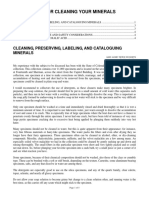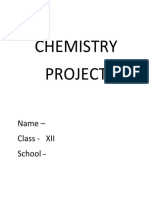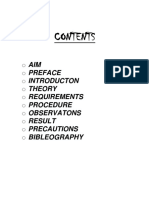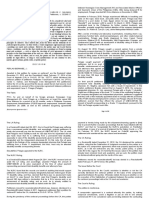Folder Engels Smac 10
Folder Engels Smac 10
Uploaded by
krittapuk sripreanjanCopyright:
Available Formats
Folder Engels Smac 10
Folder Engels Smac 10
Uploaded by
krittapuk sripreanjanOriginal Title
Copyright
Available Formats
Share this document
Did you find this document useful?
Is this content inappropriate?
Copyright:
Available Formats
Folder Engels Smac 10
Folder Engels Smac 10
Uploaded by
krittapuk sripreanjanCopyright:
Available Formats
'DITMAR' SLURRY MILLS
Dust and screened sugar contain conglomerates. Conglomerates, how small they are, grow as conglomerates
and never produce normal crystals. A footing built up from dust or screened sugar also will contain
conglomerates.
Conglomerates are not bright and deprive the product of its luster. A further disadvantage is that they are
difficult to wash and syrup, containing non-sugars, will stay behind in the product. This sugar is less tenable
and deteriorates in storage.
Even for raw-sugar it has its advantages to make conglornerate free crystal. The sugar will hold longer in
storage and will wash better when affining.
To expect normal crystals, a footing must be seeded with conglomerate free nuclei. When white sugar is ground
in denatured or isopropyl alcohol, all crystals, normal as well as conglomerates, are pulverized to small
particles.
Observed under a microscope, no well-shaped crystals can be seen but also no conglomerates. The mass
contains very small fragments of sugar crystals which, compared with dust or screened sugar, are very regular
in size. When growing they will recover themselves to normal shaped crystals. When seeding a footing with
this material, the result can be a very regular crystal, practical free from conglomerates. The particles are so
small that with one (charge all wanted nuclei can be shot in the pan. When seeding in high purities it is even
advisable to suck in sufficient nuclei for more strikes and cutover to other pans. This will prevent the forming
of conglomerates.
The quantity to be used depends on the capacity of the pan and the size of the crystals wanted. For crystals of
about 0.30 to 0.35 mm linear, 50-cc. slurry, as it comes from the mill, must be sucked in the pan per 100 hI.
massecuite. For organic solvent mostly is used isopropyl alcohol. When not available also can be used
denaturated alcohol ~ In connection with the inflammability of these solvents it is advisable to place the slurry
mill 6utside the laboratory.
The charge can be shot in at a low super-saturation (C = 1.05). Before reaching the "Intermediate zone" the
nuclei have developed to a size visible on a glass sample plate against an electric bulb.
Today, Slurry" is used in all kinds of strikes, from fine granulated refinery sugars to low grade molasses strikes.
It is also used for the manufacturing of tablet and cubes. It is possible to make such small crystals in, Slurry"
that without mixing with smear or grounded sugar, well-shaped and brilliant tablets and cubes can be made
with a minimum of breakage. These tablets are quick melters. We were informed that with normal sugar,
factories that had before less than 60% crystals in the main screening fraction, after the use of "Slurry" now
have more than 85% in the same fraction. Dust and scalings, which have to be remelted, were down to about
nothing.
To produce "Slurry" in -a reasonable time we have developed showed slurry mills, type SMAC-l0 with a
capacity of 10 liter.
Instructions for use of Slurry Mills: Report of the Applied Sugar Laboratories Inc., New York
Type SMAC-10 - capacity per batch 10 liter Fig. 1 After 4 hours running of the mill type SMAC the results were:
The same as above but starts with 8 liter alcohol and adds 4 liter
sugar crystals. Size in microns Number % total
Before starting another batch, wash out the mill properly with an 1-5 microns 58 40,0
organic solvent. The ratio alcohol sugar should not be less than 2: 1, 6-10 microns 44 30,0
otherwise there is not enough movement of the mass in the mill and
11-20 microns 35 24.1
the slurry will not discharge.
After settling, surplus of solvent can be decanted. over 20 microns 8 5,5
Note: After 4 hours running the mill type SMACS produces about 95%
nuclei below 10 microns.
More than 800 of these Slurry Mills are in use all over the world.
Ditmar Zonen B.V. Larix 20 1628 MS Hoorn Holland www.ditmarzonen.com
You might also like
- Complete MDMA SyntheseDocument28 pagesComplete MDMA SyntheseDrCrackBadger80% (66)
- Society Noc FormatDocument1 pageSociety Noc Formatshailesh latkarNo ratings yet
- Rosé Understanding The Pink Wine RevolutionDocument2 pagesRosé Understanding The Pink Wine RevolutionMatejLuknárNo ratings yet
- Lifeforce Compact Ez 1Document4 pagesLifeforce Compact Ez 1ctaslacaNo ratings yet
- Glass Fusing Design Techniques with Powders on Fiber PaperFrom EverandGlass Fusing Design Techniques with Powders on Fiber PaperRating: 3.5 out of 5 stars3.5/5 (4)
- What Is Colloidal SilicaDocument5 pagesWhat Is Colloidal SilicaJmt IndiaNo ratings yet
- Will Schran Cone 6 Crystals PDFDocument4 pagesWill Schran Cone 6 Crystals PDFjaguilar333No ratings yet
- Colloidal Silver Generator InstructionsDocument16 pagesColloidal Silver Generator InstructionsPol ErnNo ratings yet
- Complete MDMA SyntheseDocument28 pagesComplete MDMA SynthesePKM100% (1)
- Complete MDMA SyntheseDocument28 pagesComplete MDMA SyntheseGoldenNo ratings yet
- Mold Making TechniquesDocument15 pagesMold Making TechniquesJavier Ignacio Luna Crook100% (6)
- Manual of Formulas - Recipes, Methods & Secret ProcessesFrom EverandManual of Formulas - Recipes, Methods & Secret ProcessesRating: 4.5 out of 5 stars4.5/5 (2)
- RefineryDocument14 pagesRefinerykrishna sharmaNo ratings yet
- Bismuth Crackle W-Notes by Ned G - 2 PDFDocument6 pagesBismuth Crackle W-Notes by Ned G - 2 PDFPijush SarkarNo ratings yet
- Soap Is ADocument4 pagesSoap Is ASahil DasNo ratings yet
- Chemical Process Industries (Ch-211) Sugar Industry Instructor: Abdul Wahab Department of Chemical Engineering (Dche)Document41 pagesChemical Process Industries (Ch-211) Sugar Industry Instructor: Abdul Wahab Department of Chemical Engineering (Dche)ibrahim AbbasNo ratings yet
- Molasses - Carriage On TankersDocument17 pagesMolasses - Carriage On TankersMartin HislopNo ratings yet
- Sir C R Reddy PG College, EluruDocument8 pagesSir C R Reddy PG College, ElururaghaknNo ratings yet
- Alchemy 101 Workbook. Full ColourDocument78 pagesAlchemy 101 Workbook. Full ColourMichael MationschekNo ratings yet
- Sugar Manufacturing Process DiscriptionDocument6 pagesSugar Manufacturing Process DiscriptionMuhammad Junaid0% (1)
- 1 Printing With Alcohol ReplacementsDocument16 pages1 Printing With Alcohol ReplacementsarieldlustreNo ratings yet
- Tips For Cleaning Your MineralsDocument5 pagesTips For Cleaning Your MineralsdbNo ratings yet
- Unit OperationsDocument4 pagesUnit OperationsCeazar Justine Fulugan100% (1)
- Ceramic Candle Filter: Suitable Conditions Advantages DisadvantagesDocument5 pagesCeramic Candle Filter: Suitable Conditions Advantages DisadvantagesVishal DhandeNo ratings yet
- Foam Capacity of Soap Chemistry Investgatory Project Class XiDocument14 pagesFoam Capacity of Soap Chemistry Investgatory Project Class XiSubham SharmaNo ratings yet
- Preparing & Storing GlazeDocument4 pagesPreparing & Storing GlazeGianmarcoMolinaNo ratings yet
- Chemistry Project On Foaming Capacity of SoapsDocument7 pagesChemistry Project On Foaming Capacity of SoapsShaila BhandaryNo ratings yet
- Silica Sand ProductDocument19 pagesSilica Sand ProductJeEJyZa100% (2)
- Steven BranfManDocument5 pagesSteven BranfManStefan Van CleemputNo ratings yet
- Cleaning Rock and Mineral SpecimensDocument2 pagesCleaning Rock and Mineral SpecimensPhotoArtist100% (1)
- 02 Affination Mingling Centrifugation MeltingDocument2 pages02 Affination Mingling Centrifugation MeltingjantskieNo ratings yet
- Project Report 2024Document35 pagesProject Report 2024amargs4774No ratings yet
- Shali PatchDocument2 pagesShali PatchPrashant BaruaNo ratings yet
- Adobe Scan Sep 12, 2024Document17 pagesAdobe Scan Sep 12, 2024doyaj14125No ratings yet
- Class 12th Chemistry Project On Cleaning Action of SoapsDocument22 pagesClass 12th Chemistry Project On Cleaning Action of SoapschituNo ratings yet
- Cleaning Rock and Mineral SpecimensDocument2 pagesCleaning Rock and Mineral SpecimenseasybobNo ratings yet
- Basic Info About Glaze FormulationsDocument3 pagesBasic Info About Glaze FormulationsThongMaVanNo ratings yet
- Class 12th Chemistry Project On Cleaning Action of SoapsDocument22 pagesClass 12th Chemistry Project On Cleaning Action of SoapsPremlata JoshiNo ratings yet
- ExplosivesDocument5 pagesExplosivesDankoNo ratings yet
- Class 12th Chemistry Project On Cleaning Action of Soaps 1Document17 pagesClass 12th Chemistry Project On Cleaning Action of Soaps 1ankur bharali60% (5)
- ChelseaDocument1 pageChelseafarizkurnia1067No ratings yet
- Class 12th Chemistry Project on Cleaning Action of Soaps_removedDocument19 pagesClass 12th Chemistry Project on Cleaning Action of Soaps_removedgvinayagam146No ratings yet
- Tushar Pundir Chemistry ProjectDocument15 pagesTushar Pundir Chemistry ProjectTushar ThakurNo ratings yet
- NCERT Class 9 Science Lab Manual - Solution, Colloids, Suspension - CBSE TutsDocument5 pagesNCERT Class 9 Science Lab Manual - Solution, Colloids, Suspension - CBSE TutsTANISH BORALNo ratings yet
- Soaps and DetergentsDocument11 pagesSoaps and DetergentsNeetika Mishra100% (3)
- SugarDocument19 pagesSugarashutoshNo ratings yet
- Preaparation of Nail, Polish, Soap, Nail Polish Remover EtcDocument48 pagesPreaparation of Nail, Polish, Soap, Nail Polish Remover EtcShubham Sehgal100% (1)
- Sugar Production ProcessDocument2 pagesSugar Production ProcessedmarkNo ratings yet
- Soap Making ProcessDocument6 pagesSoap Making ProcessRivaldi Ahmad HaedirNo ratings yet
- GrowingAlumCrystals 1Document1 pageGrowingAlumCrystals 1sher123No ratings yet
- Know Your PlasterDocument2 pagesKnow Your PlasterVicky HsuNo ratings yet
- Young's Demonstrative Translation of Scientific Secrets: Or, A Collection of Above 500 Useful Receipts on a Variety of SubjectsFrom EverandYoung's Demonstrative Translation of Scientific Secrets: Or, A Collection of Above 500 Useful Receipts on a Variety of SubjectsNo ratings yet
- Stained Glass Projects for Beginners: 31 Projects to Make in a WeekendFrom EverandStained Glass Projects for Beginners: 31 Projects to Make in a WeekendRating: 5 out of 5 stars5/5 (2)
- Creative Polymer Clay: Over 30 Techniques and Projects for Contemporary Wearable ArtFrom EverandCreative Polymer Clay: Over 30 Techniques and Projects for Contemporary Wearable ArtNo ratings yet
- Frye's Practical Candy Maker: Comprising Practical Receipts for the Manufacture of Fine "Hand-Made" CandiesFrom EverandFrye's Practical Candy Maker: Comprising Practical Receipts for the Manufacture of Fine "Hand-Made" CandiesNo ratings yet
- How to Make Candy: A Complete Hand Book for Making All Kinds of Candy, Ice Cream, Syrups, Essences, Etc., EtcFrom EverandHow to Make Candy: A Complete Hand Book for Making All Kinds of Candy, Ice Cream, Syrups, Essences, Etc., EtcNo ratings yet
- Document 1Document1 pageDocument 1sai5charan5bavanasiNo ratings yet
- Upward Leadership - LassiterDocument2 pagesUpward Leadership - Lassiterdreea_mNo ratings yet
- Data 76Document4 pagesData 76Abhijit BarmanNo ratings yet
- Comparative Analysis of HSPR, VRRP and GLPB Network Redundancy ProtocolsDocument7 pagesComparative Analysis of HSPR, VRRP and GLPB Network Redundancy ProtocolsMANTECH PublicationsNo ratings yet
- EV Drag Coefficients Aim For TDocument2 pagesEV Drag Coefficients Aim For Tfangs997No ratings yet
- Fume Hood Canada Government Design SpecificationsDocument100 pagesFume Hood Canada Government Design Specificationscgoveia3No ratings yet
- R/3 Architecture Client Server Technologies Layer and Uses: SAP R/3 Full Life Cycle ImplementationDocument148 pagesR/3 Architecture Client Server Technologies Layer and Uses: SAP R/3 Full Life Cycle ImplementationsajidsfaNo ratings yet
- Lista de Precios Actualizada 15-01-2024Document87 pagesLista de Precios Actualizada 15-01-2024WINDERNo ratings yet
- Z Biotech - RevisedDocument51 pagesZ Biotech - Revisedrani padamavathiNo ratings yet
- The Ministry of Finance University of Finance - Marketing Marketing DepartmentDocument36 pagesThe Ministry of Finance University of Finance - Marketing Marketing Departmentrambo kunNo ratings yet
- Study Unit 1: Part A: OverviewDocument10 pagesStudy Unit 1: Part A: OverviewTevin VellooNo ratings yet
- List of Tax 1 Cases For DigestDocument3 pagesList of Tax 1 Cases For DigestLGU - SUAL PANGASINAN100% (1)
- Spliced Concrete Girder Projects PDFDocument24 pagesSpliced Concrete Girder Projects PDFSanjay GargNo ratings yet
- Matlab Lect 2Document25 pagesMatlab Lect 2Qamar AbbasNo ratings yet
- Prevention of Ergonomic Injuries Training Manual 31Document38 pagesPrevention of Ergonomic Injuries Training Manual 31api-709086807No ratings yet
- Apache Server On Windows 7 Opening Up Ports?: 7 AnswersDocument3 pagesApache Server On Windows 7 Opening Up Ports?: 7 Answersbluebird1969No ratings yet
- SHS GENMATH AY 23-24 8 Business MathematicsDocument70 pagesSHS GENMATH AY 23-24 8 Business Mathematics11-13D MANAIG MattNo ratings yet
- Arbitration Set 5Document82 pagesArbitration Set 5John Adrian MaulionNo ratings yet
- 5s Audit ChecklistDocument2 pages5s Audit ChecklistPhương ThảoNo ratings yet
- Annuitant Dependent Verification AffidavitDocument5 pagesAnnuitant Dependent Verification AffidavitOcp TreceMartiresNo ratings yet
- D. Channel ManagementDocument33 pagesD. Channel ManagementM Yasir AliNo ratings yet
- DSCManualDocument19 pagesDSCManualgauravpsaxena1978No ratings yet
- Emailing 3nethra - Neo - Brochure PDFDocument6 pagesEmailing 3nethra - Neo - Brochure PDFMrunali PatilNo ratings yet
- Syria ResolutionDocument4 pagesSyria ResolutionUK Mission to the UN100% (1)
- SA2003-000019 A en Trip Circuit Supervision With RXMB 1 Auxiliary RelayDocument1 pageSA2003-000019 A en Trip Circuit Supervision With RXMB 1 Auxiliary RelayErmin FazlicNo ratings yet
- Vadodara Municipal Corporation Development of A Perspective and A Vision of The CityDocument10 pagesVadodara Municipal Corporation Development of A Perspective and A Vision of The CityRaj SakariaNo ratings yet
- LJAG September 08Document2 pagesLJAG September 08Loughborough JunctionNo ratings yet
- Little Mermaid 2024 ScoreDocument68 pagesLittle Mermaid 2024 ScoreJulia ZusiNo ratings yet
- OGI 2016 Media KitDocument5 pagesOGI 2016 Media KitMatthew PattenNo ratings yet

























































































